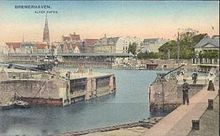Old Port (Bremerhaven)
The old port was the first port in Bremerhaven . Only remnants are left as the museum harbor of the German Maritime Museum (DSM).
history
Bremerhaven's first artificial harbor basin was built in the years 1827–1830. Dutch contractors were commissioned with the implementation because they expected the necessary technical and organizational knowledge in hydraulic engineering . The Dutch hydraulic engineer Jacobus Johannes van Ronzelen was responsible for the construction supervision . A year earlier he had prepared the appraisal for the facility and in 1827 was employed as Bremen's port construction director and construction officer.
The port was 750 meters long, 57.5 meters wide and 5.25 meters deep and got a lock with an outer port on the Weser . The docks had to be dug out by hand and the excavation removed with simple carts. Up to 900 workers from close and distant surroundings did hard work with meager wages and poor working conditions. The foundation stone for the lock was laid on July 12, 1828. Just two years later, on September 1, 1830, the port was completed. The quays , initially made of oak beams and fascines , were bricked up from 1862. In some cases, the ships also had to lie on dolphins , and the goods were loaded and unloaded via jetties and their own loading booms . As the first solid stone building in Bremerhaven, the Bremisches Amtshaus was built on the harbor in 1829 .
From 1847 to 1852 the New Harbor was built between the inner city of Bremerhaven and the Weser dike .
There was a wooden hand crank crane, others in the mid-19th century, which were later replaced by steam and electric cranes. A hand crank crane from 1875 has been preserved near its original location on what is now the outdoor area of the German Maritime Museum (DSM).
The old port began to be used as a fishing port in 1891, and fish auctions were also held from 1892. However, the importance of the fishing industry for Bremerhaven declined with the "fishing clause", an agreement with Prussia and was completely discontinued in 1935 at the Old Harbor. The preserved, listed customs house was built in 1897 according to plans by the hydraulic engineer Jacobus Johannes van Ronzelen .
After a connection with the New Harbor , the lock to the outer harbor was closed in 1928 and filled in in 1933.
The museum harbor
According to Kurt Leibbrand's general traffic plan , the Hafenrandstrasse was built as an efficient connection between Geestemünde and the overseas ports. For this purpose, the old port was halved lengthways with a sheet pile wall and filled with sand. In 1999 the old quay was restored for further museum ships. The following ships are located here:
- Bark Seute Deern , until 2020
- Deep sea tug Seefalke
- Whalers RAU IX
- Schnellboot Kranich - P 6083, until 2008
- Haffkahn Emma
- Inland tug Helmut
- Lightship Mayor Abendroth
- Submarine Wilhelm Bauer (ship, 1945)
Between the harbor basin and the Maritime Museum are:
- Concrete ship Paul Kossel
- Port tug Stier with Voith Schneider drive
- Sailing yacht Diva
- Hydrofoil WSS 10
The ghost ship
For a short time at the beginning of the Nazi era, the ghost ship was also in the Old Harbor .
Use today
The area of the old harbor and the new harbor has been expanded into a leisure and adventure mile - the “ new city center ”. Between the zoo by the sea and the maritime museum was u. a. the climate house 8º east .
memory
At the end of the filled-in driveway, the Shipping History Society of Bremerhaven commemorates the lock to the old port with a text plaque and two reproduced memorial plaques:
The replicas are reminiscent of the construction of the first Bremerhaven port, the Old Port, 1827–1830. The lock, which was filled in in 1933, had a chamber 55 meters long and an entrance width of 11 meters. The inscription on the plaque next to the Bremen state coat of arms read:
The Free State of Bremen had this harbor built by the builder Jacob Johann van Ronzelen as a secure anchorage for shipping for all peoples who use the Weser. The foundation stone was laid under the northwest corner of the lock basin on July 12, 1828. The lock was opened on September 12, 1830.
literature
- Herbert Black Forest : The Great Bremen Lexicon . 2nd, updated, revised and expanded edition. Edition Temmen, Bremen 2003, ISBN 3-86108-693-X .
Web links
- Museum Harbor (Official Website Bremerhaven)
Coordinates: 53 ° 32 ′ 31 ″ N , 8 ° 34 ′ 38 ″ E



